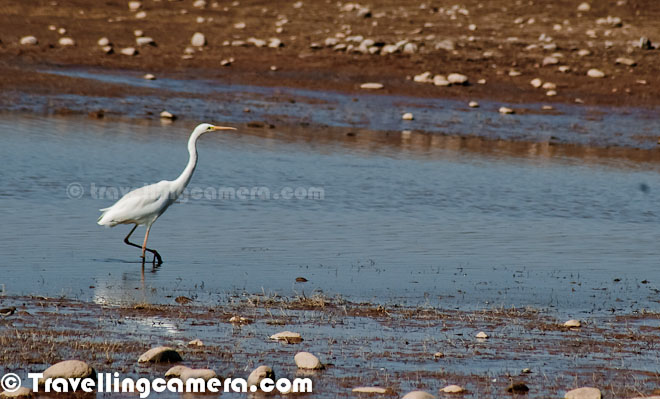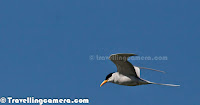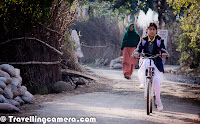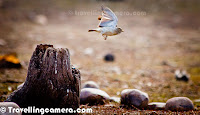Wild Wings of Pong Dam : A Series on Migratory Birds we saw at Pong Water reservoir during Winters of 2012 @ Himachal Pradesh India || PART-2
Continuing this series of Photo Journeys with Wild Wings of Pong Dam, here comes the second Photo Journey of this series. Let's check out this one with new birds we met during Bird Counting Activity at Pong Dam Lake in Himachal Pradesh, India.
The very first bird of this Photo Journey is 'Grey Buschat'
Grey Buschat is found in countries like Bangladesh, Bhutan, Cambodia, China, India, Japan, Laos, Myanmar, Nepal, Pakistan, Taiwan, Thailand, and Vietnam. And I think this was not Migratory bird for Pong Wetland, but not sure. Its natural habitats are subtropical or tropical moist lowland forests and subtropical or tropical moist montane forests. And this one was not exactly found near the lake. We saw it on the way while moving from Forest Guest House in Nagrota to the Lake-side.
Grey Buschat is found in countries like Bangladesh, Bhutan, Cambodia, China, India, Japan, Laos, Myanmar, Nepal, Pakistan, Taiwan, Thailand, and Vietnam. And I think this was not Migratory bird for Pong Wetland, but not sure. Its natural habitats are subtropical or tropical moist lowland forests and subtropical or tropical moist montane forests. And this one was not exactly found near the lake. We saw it on the way while moving from Forest Guest House in Nagrota to the Lake-side.
A Silhouette of Grey Heron
Most of the time we were walking around the Shoreline of Pong Dam Lake and all birds were against the light for us. Only few like Bar Headed Goose and Ruddy Shelducks were on other side. So I thought of trying some Silhouette Shots and some of them came out really well due to amazing shapes of these birds in air and around the lake.
The Grey Heron is a wading bird of the heron family Ardeidae, native throughout temperate Europe, Asia and also parts of Africa. It is resident in the milder south and west, but many birds retreat in winter from the ice in colder regions. It has become common in summer even inside the Arctic circle along the Norwegian coast. (Courtesy - http://en.wikipedia.org/wiki/Grey_Heron)
Most of the time we were walking around the Shoreline of Pong Dam Lake and all birds were against the light for us. Only few like Bar Headed Goose and Ruddy Shelducks were on other side. So I thought of trying some Silhouette Shots and some of them came out really well due to amazing shapes of these birds in air and around the lake.
The Grey Heron is a wading bird of the heron family Ardeidae, native throughout temperate Europe, Asia and also parts of Africa. It is resident in the milder south and west, but many birds retreat in winter from the ice in colder regions. It has become common in summer even inside the Arctic circle along the Norwegian coast. (Courtesy - http://en.wikipedia.org/wiki/Grey_Heron)
Gull floating on top of Pong Dam Lake @ Himachal Pradesh, India
During this trip I was most impressed by activeness of Gulls and River Terns although not sure if these birds are so active by their nature or not :) ... There were different types of Gulls and people were actually identifying gulls with exact features and for me all of them were Gulls :) ...
Gulls are typically medium to large birds, usually grey or white, often with black markings on the head or wings. They typically have harsh wailing or squawking calls, stout, longish bills, and webbed feet. Most gulls, particularly Larus species, are ground-nesting carnivores, which will take live food or scavenge opportunistically. Live food often includes crabs and small fish. Gulls have prophylactic unhinging jaws which allow them to consume large prey. Apart from the kittiwakes, gulls are typically coastal or inland species, rarely venturing far out to sea The large species take up to four years to attain full adult plumage, but two years is typical for small gulls. Large White-Headed Gulls are typically long-lived birds, with a maximum age of 49 years recorded for the Herring Gull. If interested in more details about Gulls, check out - http://en.wikipedia.org/wiki/Gull
During this trip I was most impressed by activeness of Gulls and River Terns although not sure if these birds are so active by their nature or not :) ... There were different types of Gulls and people were actually identifying gulls with exact features and for me all of them were Gulls :) ...
Gulls are typically medium to large birds, usually grey or white, often with black markings on the head or wings. They typically have harsh wailing or squawking calls, stout, longish bills, and webbed feet. Most gulls, particularly Larus species, are ground-nesting carnivores, which will take live food or scavenge opportunistically. Live food often includes crabs and small fish. Gulls have prophylactic unhinging jaws which allow them to consume large prey. Apart from the kittiwakes, gulls are typically coastal or inland species, rarely venturing far out to sea The large species take up to four years to attain full adult plumage, but two years is typical for small gulls. Large White-Headed Gulls are typically long-lived birds, with a maximum age of 49 years recorded for the Herring Gull. If interested in more details about Gulls, check out - http://en.wikipedia.org/wiki/Gull
Intermediate Egret walking around backwater streams of Pong Dam Lake in Himachal Pradesh, India.
The Intermediate Egret or Yellow-billed Egret is a medium-sized heron. It is a resident breeder from east Africa across the Indian Subcontinent to Southeast Asia and Australia. It often nests in colonies with other herons, usually on platforms of sticks in trees or shrubs. Two to five eggs are laid, the clutch size varying with region. This species, as its scientific name implies, is intermediate in size between the Great Egret and smaller white egrets like the Little Egret and Cattle Egret, though nearer to Little than Great. Breeding birds may have a reddish or black bill, greenish yellow gape skin, loose filamentous plumes on their breast and back, and dull yellow or pink on their upper legs (regional variations). The sexes are similar. Check out http://en.wikipedia.org/wiki/Intermediate_Egret for more details about Intermediate Egrets...
The Intermediate Egret or Yellow-billed Egret is a medium-sized heron. It is a resident breeder from east Africa across the Indian Subcontinent to Southeast Asia and Australia. It often nests in colonies with other herons, usually on platforms of sticks in trees or shrubs. Two to five eggs are laid, the clutch size varying with region. This species, as its scientific name implies, is intermediate in size between the Great Egret and smaller white egrets like the Little Egret and Cattle Egret, though nearer to Little than Great. Breeding birds may have a reddish or black bill, greenish yellow gape skin, loose filamentous plumes on their breast and back, and dull yellow or pink on their upper legs (regional variations). The sexes are similar. Check out http://en.wikipedia.org/wiki/Intermediate_Egret for more details about Intermediate Egrets...
Large Cormorants
Little Cormorant with spreaded wings @ Pong Dam Lake
The Little Cormorant is a member of the Cormorant family of seabirds: Aptly named, the Little Cormorant is small in comparison with other cormorants, only 55 cm in length with an average mass of 440 gms. Salim Ali describes the Little Cormorant as a 'glistening black duck-like water bird with a longish stiff tail and slender compressed bill sharply hooked at the tail.' It is a resident species in most of tropical south Asia, commonly found in Bangladesh, Bhutan, Cambodia, China, India, Indonesia, Lao People's Democratic Republic, Malaysia, Myanmar, Nepal, Pakistan, Sri Lanka, Thailand, and Viet Nam; additionally, it is a vagrant species in Afghanistan. The Little Cormorant is not a migratory bird... it dwells year-round in trees near a water source.
The Little Cormorant is a member of the Cormorant family of seabirds: Aptly named, the Little Cormorant is small in comparison with other cormorants, only 55 cm in length with an average mass of 440 gms. Salim Ali describes the Little Cormorant as a 'glistening black duck-like water bird with a longish stiff tail and slender compressed bill sharply hooked at the tail.' It is a resident species in most of tropical south Asia, commonly found in Bangladesh, Bhutan, Cambodia, China, India, Indonesia, Lao People's Democratic Republic, Malaysia, Myanmar, Nepal, Pakistan, Sri Lanka, Thailand, and Viet Nam; additionally, it is a vagrant species in Afghanistan. The Little Cormorant is not a migratory bird... it dwells year-round in trees near a water source.
During two days Pong Dam Lake, I used to see Little Cormorants after every 10 minutes. Not very sure but these birds seemed friendly to others, as many times we spotted little Cormorants with either Gulls, Herons or Egrets etc. More photographs for Cormorants can be checked at - http://phototravelings.blogspot.in/2012/02/different-types-of-cormorants-at-pong.html
Little Egret with Black Headed Gull
The adult Little Egret is 55–65 centimeters long with an 88–106 centimeters wingspan and weighs 350–550 grams. Its plumage is all white. The subspecies garzetta has long black legs with yellow feet and a slim black bill. In the breeding season, the adult has two long nape plumes and gauzy plumes on the back and breast, and the bare skin between the bill and eyes becomes red or blue. Juveniles are similar to non-breeding adults but have greenish-black legs and duller yellow feet. has yellow feet and a bare patch of grey-green skin between the bill and eyes. The subspecies nigripes differs in having yellow skin between the bill and eye, and blackish feet. Little Egrets are mostly silent but make various croaking and bubbling calls at their breeding colonies and produce a harsh alarm call when disturbed. Check out http://en.wikipedia.org/wiki/Little_Egret to know more about Little Egrets.
The Black-headed Gull is a bold and opportunist feeder which will eat insects, fish, seeds, worms, scraps and carrion in towns, or take invertebrates in ploughed fields with equal relish. This species takes two years to reach maturity. First-year birds have a black terminal tail band, more dark areas in the wings, and, in summer, a less fully developed dark hood. Like most gulls, Black-headed Gulls are long-lived birds, with a maximum age of 63 years recorded in the wild. Check more about Black Headed Gulls at http://en.wikipedia.org/wiki/Black-headed_Gull . At Pong Dam Lake, I loved their flight and the way they take whole round of the lake by flying on top of it.
The adult Little Egret is 55–65 centimeters long with an 88–106 centimeters wingspan and weighs 350–550 grams. Its plumage is all white. The subspecies garzetta has long black legs with yellow feet and a slim black bill. In the breeding season, the adult has two long nape plumes and gauzy plumes on the back and breast, and the bare skin between the bill and eyes becomes red or blue. Juveniles are similar to non-breeding adults but have greenish-black legs and duller yellow feet. has yellow feet and a bare patch of grey-green skin between the bill and eyes. The subspecies nigripes differs in having yellow skin between the bill and eye, and blackish feet. Little Egrets are mostly silent but make various croaking and bubbling calls at their breeding colonies and produce a harsh alarm call when disturbed. Check out http://en.wikipedia.org/wiki/Little_Egret to know more about Little Egrets.
The Black-headed Gull is a bold and opportunist feeder which will eat insects, fish, seeds, worms, scraps and carrion in towns, or take invertebrates in ploughed fields with equal relish. This species takes two years to reach maturity. First-year birds have a black terminal tail band, more dark areas in the wings, and, in summer, a less fully developed dark hood. Like most gulls, Black-headed Gulls are long-lived birds, with a maximum age of 63 years recorded in the wild. Check more about Black Headed Gulls at http://en.wikipedia.org/wiki/Black-headed_Gull . At Pong Dam Lake, I loved their flight and the way they take whole round of the lake by flying on top of it.
Flying Little Ringed Plover
The Little Ringed Plover is a small plover which we saw around the backwater spots of Pong Dam Lake. Adults have a grey-brown back and wings, a white belly, and a white breast with one black neckband. They have a brown cap, a white forehead, a black mask around the eyes with white above and a short dark bill. The legs are flesh-colored and the toes are all webbed.
The Little Ringed Plover is a small plover which we saw around the backwater spots of Pong Dam Lake. Adults have a grey-brown back and wings, a white belly, and a white breast with one black neckband. They have a brown cap, a white forehead, a black mask around the eyes with white above and a short dark bill. The legs are flesh-colored and the toes are all webbed.
Little Ringed Plover finding something to eat around Lake shore...
This species differs from the larger Ringed Plover in leg color, the head pattern, and the presence of a clear yellow eye-ring.
This species differs from the larger Ringed Plover in leg color, the head pattern, and the presence of a clear yellow eye-ring.
Little Ringed Plover keeping an eye on movements around him while eating something on Lakeside...
The breeding habitat of Little Ringed Plover is open gravel areas near freshwater, including gravel pits, islands and river edges in Europe and western Asia. They nest on the ground on stones with little or no plant growth. Both male and female take turn to incubate the eggs. They are migratory and winter in Africa. These birds forage for food on muddy areas, usually by sight. They eat insects and worms.
The breeding habitat of Little Ringed Plover is open gravel areas near freshwater, including gravel pits, islands and river edges in Europe and western Asia. They nest on the ground on stones with little or no plant growth. Both male and female take turn to incubate the eggs. They are migratory and winter in Africa. These birds forage for food on muddy areas, usually by sight. They eat insects and worms.
Little Ringed Plover heading towards deep water in Pong Dam Lake, Kangra, Himachal Pradesh, India
Having said that Little Ringed Plovers find their food around muddy areas, we also found them near to the water and finding stuff to eat.
A Little Ringed Plover calling friends to join on a island for party... More about Little Ringed Plovers can be checked at http://en.wikipedia.org/wiki/Little_Ringed_Plover
You may Also Like Following PHOTO JOURNEYs -
Wild Wings of Pong Dam - Part 1
Bar Headed Goose @ Pong Water Reservoir, HP, India
First encounter with Ruddy Shelducks around Pong Dam Lake
Different Types of Cormorants at Pong Water Reservoir in Himachal
Ellora of Himachal Pradesh
A Photo Journey with Bird Silhouettes
A Quick Visit to Pong Dam and surrounding areas of the Lake
Sunset Moments at Pong Dam Lake in Kangra
A Photo Journey with Rural Himachal - Nagrota Surian on the bank of Pong Dam Lake.
Some Passionate Birders and Wildlife Professionals at Pong
Bird Counting Seminars at Wildlife Department, Pong Dam, Kangra, HP
Second part of the Series - 'Wild Wings of Pong Dam'
You may Also Like Following PHOTO JOURNEYs -
Wild Wings of Pong Dam - Part 1
Bar Headed Goose @ Pong Water Reservoir, HP, India
First encounter with Ruddy Shelducks around Pong Dam Lake
Different Types of Cormorants at Pong Water Reservoir in Himachal
Ellora of Himachal Pradesh
A Photo Journey with Bird Silhouettes
A Quick Visit to Pong Dam and surrounding areas of the Lake
Sunset Moments at Pong Dam Lake in Kangra
A Photo Journey with Rural Himachal - Nagrota Surian on the bank of Pong Dam Lake.
Some Passionate Birders and Wildlife Professionals at Pong
Bird Counting Seminars at Wildlife Department, Pong Dam, Kangra, HP
Second part of the Series - 'Wild Wings of Pong Dam'



























.jpg)
Comments